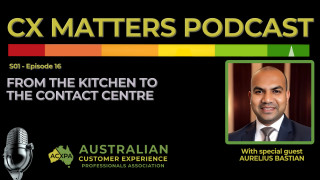In addition to the glossary term below, ACXPA Members also have access to a range of additional resources, including our Member Symposiums & Video Library, premium resources to download, exclusive industry insights & data, discounted training courses and lots more!
Failure Demand
Are you ignoring one of the greatest levers you have for improving performance in your contact centre?
The current narrative on services is that demand is rising and budgets are struggling to cope.
Not a week goes by without more talk to support that point of view.
This narrative is no more than that – a point of view.
The problem is that this narrative is not grounded in evidence.
Demand is rising, but the thing that contributes almost wholly to the rise is what we call failure demand.
To put it at its bluntest: our services don’t work well for people – that is why demand appears to be ‘rising’.
A local Australian example of services not working very well for people was an article penned by Dan McCulloch, Australian Associated Press, titled “Centrelink call centre phones ‘busy’ 28 million times” written back in 2018.
In his article, Dan wrote:
- Callers trying to contact Centrelink have been met with “busy” signals 28 million times in just seven months.
- For those who do get through … Centrelink’s average contact centre wait time stands at 14 minutes and 10 seconds.
- If a call is answered and then transferred to another operator, the time the caller spends languishing on hold is wound back to zero.
- Greens Senator Rachel Siewert said … “Behind those 28 million attempts are exasperated and struggling Australians. It should not be this hard to access Centreline, the government should wake up to how broken the system is,” she said.
The good news is the attention worked at the time, Services Australia (who are responsible for Centrelink) advised us in April 2021 that customers have not received a busy signal since May 2020.
As recently as June 2023, Services Australia announced they were axing their call centre contract with Serco Group leaving ~600 call centre workers out of job, and the potential for more disruptive service to Centrelink.
However, the article is not about Centrelink.
The focus of the article is the volume of contacts and how long people had to wait on hold, in other words, treating incoming contacts (demand) as work to be done.
It is to ignore failure demand; one of the greatest levers for improving performance.
In service organisations, whether in the private or public sector, failure demand often represents the greatest lever for performance improvement.
You might be surprised to learn that In financial services it can account for anything from 20 to 60 per cent of all customer demand, in utilities as much as 80 per cent.
In the public sector, it is generally as high as in utilities; in local authorities and police forces, as much as 80 or 90 per cent of contacts are avoidable and unnecessary.
In the latest Australian Contact Centre Industry Benchmarking report, contact centres reported on average, 31% of all contacts were as a direct result of Failure Demand.
Imagine the impact of turning it off: better service and much lower costs.
What is Failure Demand?
Whenever we meet executives, worldwide, and talk to them about failure demand, we get the same response “I haven’t heard of failure demand before, I’ve never thought of the world like that… but I can see the opportunity to improve my organisation is immense.”
It is such a simple concept, yet understanding it, and acting on it, is the single greatest lever managers have for improving performance.
However, until they learn about failure demand, and more importantly its causes, it is an invisible problem.
We often point out that failure demand is easily understood, and just as easily misunderstood.
Vanguard invented the concept of failure demand when we discovered that the movement of ‘telephone work’ to contact centres from local bank branches in the 1980s caused an explosion in the volumes of demand – the number of phone calls soared.
We found that the rise in call volumes was attributable to the creation of failure demand, in other words, people ringing back because they did not get their problem solved the first time.
The same phenomenon also occurred in the public sector as local authorities and housing associations moved telephone work into contact centres.
It is also evident today in all sectors when organisations go ‘Digital by default’.
It took us seven years before we settled on a codification for customer demands – value demand & failure demand.
The definition of a value demand is ‘Demand we want’: Why we are here from the customers’ point of view.
The definition of failure demand is ‘Failure demand is demand caused by a failure to do something or do something right for the customer’.
We found this definition works in every type of service organisation.
Although each type of service can create its own distinct kinds of failure demand.
Defining failure demand this way is to recognise that it represents a failure of either commission or omission from the customers’ point of view.
In either case, it means that the customer is obliged to contact the organisation again if he or she wants to get the service as desired, the corollary being that service provision costs more (rectifying mistakes, duplication, etc).
Failure demand is systemic – a natural consequence of an industrial service design – and is compounded by technology.
For example, most service organisations have invested heavily in workflow management systems to log, scan, sort, batch, queue, allocate and measure work and worker activity.
These tasks tend to be highly valued by management but, paradoxically, are often a major cause of failure demand and waste (cost).
The concepts of value demand and failure demand have achieved such resonance that they have now form the lingua franca amongst those inside and outside the contact centre world.
The concern is that the obvious appeal of the failure demand concept will lead managers to miss the real opportunity.
Unfortunately, they will be aided in that by – all who know how to sell to someone who is preoccupied with costs.
The bandwagon now following failure demand includes IT providers offering new or upgraded IT systems for monitoring and tracking failure demand.
The irony!

Managers don’t need IT systems to get the benefit of working with failure demand; indeed, they will only get in the way.
The snake-oil providers make beguiling use of cost-benefit analyses to make the case for investing in a technology-led programme of change to tackle failure demand – and a case for huge savings is easy to make.
But do they know anything about method?
Do they know the causes are systemic?
Many plausible ideas will come to nothing, except for greater waste.
When the work is studied from a customers’ point of view, the impact of tools and how they make things worse for them (and those that serve them) becomes immediately obvious.
Listening to or reading what customers ask for at major points of contact, for example in the contact centre, helpdesk, sales support and so on, reveals how technology also disrupts flow, and in so doing, causes the customer further problems – resulting in even more failure demand that is then logged, sorted, batched, queued and allocated.
It is not uncommon for this Kafkaesque cycle to go through many iterations before a simple request is resolved.
Removing failure demand
Removing failure demand represents a great opportunity to increase capacity and reduce costs in your contact centre.
Ignoring the nature of demand is to ignore one of the greatest levers you have for improving performance.
We meet some leaders who have heard of failure demand, and have conducted exercises to collate measures of failure demand coming into their organisations.
They tell us the same story; “We know how much failure demand is coming in, but don’t know how to remove it.”
These leaders have been let down by bad method. What is required is a method to design failure demand out.
“We knew there was failure demand. In many cases we knew how much failure demand was there. But we didn’t know how to solve it … We just could not get rid of it. What I found really powerful with the Vanguard Method, it taught me how to take out failure demand”. Katharina Haase, Chief Operating Officer, Barclaycard Germany
As well as explaining why services don’t work very well, we understand how to design services that actually work. When services have applied our methods their costs fall dramatically. But that’s not all.
The wider consequence of providing services that work is that demand falls.
Not only do you wipe out the strangling effect of high failure demand, you learn that fewer people experience problems.
Through the application of the Vanguard Method, failure demand can be designed out in months, not years.
Moving from theory into application
Let’s look at another example of designing out failure demand, this time overseas (Failure Demand doesn’t care about geographical borders!).
One of the UK’s largest insurers has grown through acquisition.
The logic underpinning their strategy was to create ‘economies of scale’ and, as we will describe later, they experienced predictable problems associated with this flawed logic.
When we started with the insurance company their Life Insurance business had four contact centres, two in the UK and two in India together with two ‘onshore (UK) support’ centres supporting the offshore operations.
The various centres were designed along product lines (Pensions, Protection, Bonds and Annuities) and customers were supposed to route themselves via an IVR front end.
Failure demand was running at roughly 60 per cent, customer satisfaction as measured by NPS was -40 per cent and first point resolution was around 60 per cent.
As part of the overall transformation of his business, the UK Life Chief Executive was insistent that customers should be able to speak directly to a human as opposed to being confronted by a machine.
We worked with the contact centre management team over a year to systematically institutionalise systemic principles.
The first step was to undertake a qualitative demand analysis at each point of contact with the customer.
Once common themes had been established the demands were quantified as either value or failure and the highest frequency value demands (from a customers’ perspective) identified.
Every contact centre agent in the UK was systematically trained to deal with the most frequent demand irrespective of product.
This was the first counter-intuitive moment for most managers as what they learned was that the highest frequency demand was ‘I want a valuation’.
It was also the first ‘System Condition’ they had to confront, namely aligning IT to demand types and away from product type.
They took each product in turn and worked with people in the individual product groups to equip the front line to provide valuations for every product.
Each time the centre was ‘de-functionalised’, again counter-intuitively, the UK centres achieved a 20 per cent increase in capacity (80 per cent in total).
The capacity freed up through the removal of product specialisms together with reductions in failure demand achieved through action taken in product areas outside the contact centre created sufficient resource to turn off the IVR system and eliminate the need to outsource the calls to India.
The CEO’s wildest dream was achieved and at a reduced cost!
The level of customer satisfaction, for the first time ever, moved into a positive NPS number initially +40 per cent but is now constantly rising.
First point resolution moved into the high 90 per cent and failure demand reduced to around 20 per cent.
The causes of failure demand on a contact centre
The causes of failure demand lie in the design and management of work. In the public sector, managers are obliged to follow guidance that is ill-conceived.
In public services the causes of failure demand are in the design and management of work created by following central guidance, in particular, managing by targets.
This explains why politicians get grief in their surgeries despite their authority’s services being rated ‘good’ by the auditors.
Failure demand is often caused by managing contact centre workers’ activity rather than how well the service meets the customers’ needs; for example, keeping within prescribed ‘handling times’ in a service centre often means ‘closing’ the customer’s problem rather than solving it, ensuring that it comes back again later.
Managers manage contact centre worker activity on the assumption that activity equals cost, yet the counterintuitive truth is that cost is in flow – the number of transactions it takes for a customer to get a service.
The prevailing design and management of services drives the behaviour Dan McCulloch reported in his “Centrelink phones ‘busy’ 28 million times” article:
“A transfer to a new line becomes a new inquiry, and as such, the clock would start again,” Human Services staffer Barry Jackson told a Senate estimates hearing in Canberra “It becomes a new call coming into the system”
This isn’t unusual.
One organisation in the UK set their IT system to only allow in the number of calls they could pick up – so that they could meet their service level target.
It is the same for all services that we have studied, which reinforce the point that failure demand is a systemic phenomenon; you cannot get rid of it without understanding the causes, which invariably leads to the need to change the system, re-design the service and change the measures-in-use.
The good news is that managers across the globe are discovering that using the Vanguard Method they can sustainably design out failure demand to improve service AND reduce costs.
Designing and managing organisations to deliver against customer demands – customer satisfaction soars, capacity increases, and costs fall naturally.
Why not pull that lever?
Next Members Symposium Livestream: Tuesday, 21st May, 2024, 13:30 AEST
The Members Symposium sessions are only available to ACXPA Members!
ACXPA Members can watch the symposium live, and, can watch any of the sessions at any time in their Video Library.
Preview of upcoming Symposium Sessions:

IVR Best Practice
Over 90% of contact centres are using an IVR (Press 1 for this, press 2 for that), and we've encountered many contact centres with over four layers of options for customers to select from. In this session, Nadine will be sharing some best practice tips on IVR design for 2024.
Presented by Nadine Power, Chief Product Officer, Datagamz (and ACXPA National Advisory Board Member)

Tips to Boost Engagement on Calls
Of the five quality competencies we assess as part of the Australian Call Centre Rankings, the 'ENGAGE' competency from the Australian Contact Centre Quality Standards has consistently been at the bottom of the rankings throughout 2023 and into 2024.
In this session, Simon will provide some tips that can be shared with agents on how to increase engagement with customers at the start of calls.
Presented by Simon Blair, General Manager Quality Insights, ACXPA
More sessions announced soon!
(If you're interested in speaking at one of our events, click here to learn more >)
























